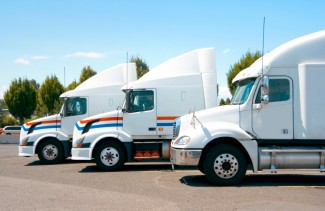The Trump administration’s efforts to roll back the light-duty vehicle fuel economy standards have received a lot of attention. Much less known is its stalling of heavy-duty vehicle fuel economy standards, which would also boost fuel consumption and greenhouse gas emissions — significantly increasing health risks for all.
Heavy-duty vehicles, such as tractor trucks, vocational vehicles, work trucks, and trailers, consume 31% of energy used by all on-road vehicles despite being just 5% of the vehicles on the road. They emit about one-fourth of the total carbon emissions from the transportation sector. In addition, heavy-duty vehicles’ share of fuel consumption globally is increasing, which makes them a critical market segment to target for improved energy efficiency.
Despite this carbon footprint, the Trump administration is stalling Phase 2 of the fuel economy and greenhouse gas emission standards for heavy-duty vehicles. Originally, the Environmental Protection Agency (EPA) and the National Highway Traffic Safety Administration (NHTSA) were slated to update the standards in two phases to facilitate the transition to more fuel-efficient vehicles. This second phase, adopted in 2016, was designed to cover a wider variety of heavy-duty vehicles as well as trailers and to extend standards beyond 2018 to 2027.
Glider trucks, in particular, are concerning. These are trucks with new bodies but old engines and transmissions. Gliders typically emit 20-40 times more emissions than today’s new diesel engines, according to testing by the EPA’s laboratory in Ann Arbor, Michigan. The Phase 2 rule placed an annual cap of 300 “glider” trucks per manufacturer that will be exempted from meeting the criteria pollutant and greenhouse gas standards. The Trump administration’s EPA tried to repeal the glider provisions, citing research funded by the glider industry. This woefully deficient research claimed that glider trucks did not produce any more emissions than those with modern diesel engines.
The EPA was not successful in its repeal after severe backlash from almost all stakeholders except the glider industry. Instead, the agency decided not to enforce the 300-unit cap through 2019, risking the health of American public. The Washington DC Court of Appeals ordered EPA to continue to enforce glider truck requirements. Yet the new EPA administrator, Andrew Wheeler, committed in his confirmation hearing to reconsider the Phase 2 glider provisions despite the opposition of the trucking industry and other stakeholders. It is hard to imagine how the administration could justify repealing the glider provisions when EPA’s Ann Arbor test results were recently found to comply with EPA standard practices by the agency’s Office of Inspector General.
Trailers for tractor trucks are another example of the EPA holding up progress. Trailers under the Phase 2 rule would have delivered an estimated 7% improvement in tractor-trailer fuel efficiency starting in model year 2018. The trailer requirements were stayed by the DC Court of Appeals in response to a legal challenge by the Truck Trailer Manufacturers Association along with EPA inaction. Despite the court’s direction that the parties file a status report every 90 days, the EPA has not provided a status update since August 2018. As a result, the nation will be consuming an extra 40,000 barrels of oil per day by 2025.
While the Trump administration is compromising federal heavy-duty fuel efficiency standards, there is progress at the state level. California will enforce standards for 2020 model year trailers, requiring manufacturers to certify trailers they want to sell in the state.
In addition, California is forging ahead on medium- and heavy-duty vehicle electrification. California has programs that incentivize the purchase of zero-emission buses and trucks. The state is now working on a program that could require half of vocational vehicles and 15% of tractor trucks sold in California to be electric by 2030.
But state programs are not enough. The federal government must act to reap the multiple benefits of efficiency standards for heavy-duty vehicles. The trucking industry and American consumers cannot afford to squander 40,000 barrels of oil per day, and the public cannot afford the health costs of that much more pollution. The EPA should enforce the glider cap in the Phase 2 rule and preserve its trailer provisions, if not enhance them. Without addressing carbon emissions from the transportation sector, there will be no realistic way for the United States to reach its climate goals.




